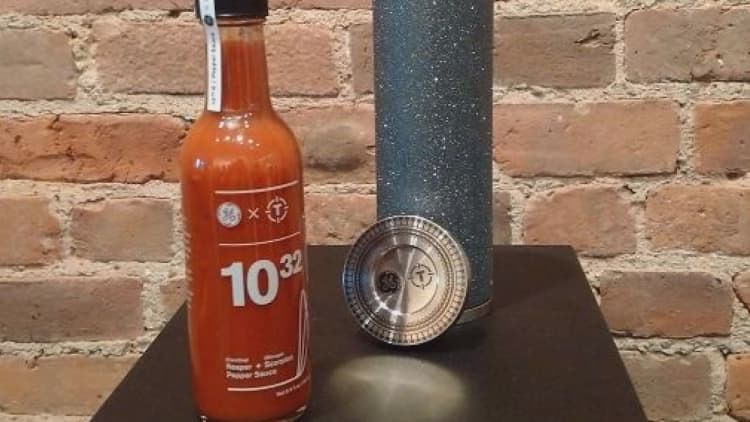
Leave it to General Electric —the company that once used grilled meat to make a point about science—to engineer its very own brand of eye-watering hot sauce.
When you hear the name GE, the last thing that springs to mind is condiments. Yet that's what the manufacturer has created, launching a limited edition line of hot sauce called 10^32 Kelvin—the temperature at which all things start to break down. The small bottle tastes as if it contains the liquid heat of a thousand suns.
Foodies' ardor for chicken wings and spicy cuisine has turned hot sauce into a global market worth nearly $2 billion in sales, according to a 2015 Euromonitor report. Yet for GE, this isn't meant to be a leap into the food business: the company will only manufacture 1,000 bottles—all of which sold out on Thrillist within the space of a few hours on Monday morning.
According to the company, it's seen as a creative way to draw attention to GE's technology prowess, helping people understand the science behind its innovations. Last year at SXSW, the company took a similarly scientific approach to making barbecue, in order to talk up its food and neuroscience capabilities.
Read MoreFall's flavors: Apple, pumpkin spice and sriracha
"In hot sauce, it's all about the heat. In jet engines, it's all about the heat," Doug Decesare, a GE global research manager in its aerothermal and mechanical technologies group, told CNBC recently.
Hence the hot sauce, which is made with two of the spiciest (and scary sounding) peppers in existence: The Carolina Reaper and the Trinidad Moruga Scorpion.
'Like a 10 pound hammer coming at you'
The average jalapeño runs about 3,500 heat units on the Scoville scale, which measures the "hotness" of peppers and spicy foods. The scale is named after its creator Wilbur Scoville, an American pharmacist who devised the Scoville Organoleptic Test in 1912. The higher the number of heat units, the more potent the heat.
When stacked up against the jalapeño, the Carolina Reaper used in GE's concoction is rated at 2.2 million heat units, and is considered the hottest pepper in the world. The Trinidad Moruga Scorpion ranks second, at 1.2 million heat units.
So how does GE put all that together in a way that tastes like something other than jet fuel?
"When you have two of the world's hottest peppers, the trickiest thing is to find ingredients that go well with those peppers so you have tasty sauce," according to High River Sauces Steve Seabury, who partnered with GE and lifestyle website Thrillist to create 10^32 Kelvin. He infused the peppers with apple, cane sugar and garlic.
"It's easy to make a spicy hot sauce but it's hard to make one that tastes good," he said. "This one smells hot. Then you get past that and you'll try it and get a little sweetness," said Seabury, an expert who's been making hot sauce for nearly a decade.
"This is definitely the hottest one I've ever made," he said about 10^32. "It's like a 10-pound hammer coming at you. Put it against my hottest sauce from the High River line and this is twice as hot."
GE's condiment is intended "to make it resonate with a jet engine being able to withstand 2,400 degrees."
"The hotter we can run the engine, the more efficient the engine and the less carbon emissions there are," Decesare explained. "But in order to run these jet engines hot, we needed a new, high temperature super-material."
It's like science
GE's ceramic matrix composites (CMCs) are engineered to function at 2,400 degrees, which is what 10^32 Kelvin feels like in the mouth. That is 400 degrees hotter than the most advanced metal alloys. CMCs are composed of tiny silicon carbide fibers that are five times thinner than human hair, and are super lightweight.
As an homage to GE's materials science and thermal technology and the heat resistant ceramic matrix, a bottle of 10^32 Kelvin hot sauce is packaged in a cylindrical container made from CMCs. The top cover of the container is made of nickel alloy, and features an image of an actual jet engine component.
"To contain the heat in a jet engine we use CMCs. So, for hot sauce, what better way to contain the heat than to use a tube made of CMCs?" Decesare said.
The sauce was offered exclusively on Thrillist, but will also be available at The Heatonist, a Brooklyn hot sauce boutique shop.
"This hot sauce represents my appetite for destruction," Seabury said. "It's the best hot sauce I've ever created."


